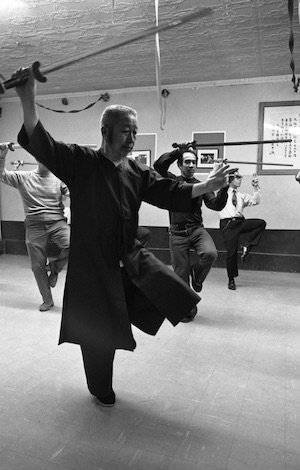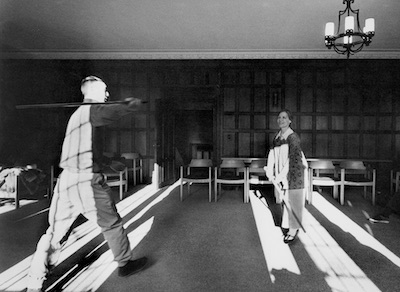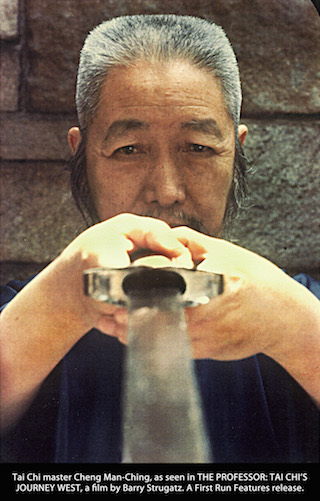FORMS
Solo and Sword

In their wisdom the ancient masters evolved the forms and passed them down. The forms are of a nature that when they are practised they inform us as to their martial and therapeutic content, while practising with the therapeutic energy in mind the healing energy is freed.
Names of CHENG MAN CH’ING’S TAI CHI SWORD
- RESPECTFULLY DECLINING
- STEP FORWARD, HAND AND SWORD
- THE IMMORTAL POINTS THE WAY
- PRESS THE APPLE
- RINGS AROUND THE MOON II
- MAJOR LITERARY STAR
- SWALLOW BEATS WATER WITH WINGS III
- BLOCK AND SWEEP, RIGHT AND LEFT II
- MINOR LITERARY STAR
- WASP ENTERS CAVE
- ALERT CAT CATCHES MOUSE
- DRAGONFLY STRIKES WATER
- MASTER SITS BACK
- SWALLOW RETURNS TO NEST
- PHOENIX SPREADS WINGS
- WHIRLING WIND, MINOR LITERARY STAR
- AWAITING THE FISH
- SEARCHING FOR SNAKE IN GRASS III
- EMBRACING MOON
- BIRDS RETURN TO FOREST
- DRAGON WAGS TAIL
- WIND ROLLS LOTUS LEAF
- LION SHAKES HEAD
- TIGER HOLDS BREATH
- WILD HORSE LEAPS STREAM
- TURN, REIN IN HORSE
- THE COMPASS
- TASSELS IN THE WIND III
- PUSH BOAT WITH CURRENT
- SHOOTING STAR CHASES MOON
- PEGASUS, THE WATERFALL
- ROLL UP SCREEN
- WHEELS LEFT AND RIGHT II
- SWALLOW STRIKES MUD
- ROC SPREADS WINGS
- PLUCK MOON FROM SEA BOTTOM
- EMBRACE MOON
- DRAGON SPIRIT SEARCHES SEA
- RHINO GAZES AT MOON
- SHOOT WILD GOOSE
- GREEN DRAGON STRETCHES CLAWS
- PHOENIX SPREADS WINGS
- BLOCK TWO SIDES II
- STRIKE WILD GOOSE
- APE OFFERS FRUIT
- FALLING FLOWERS, LEFT AND RIGHT VI
- FAIR LADY WORKS SHUTTLE
- TIGER WAGS TAIL
- FISH LEAPS DRAGON GATE
- DRAGON COILS AROUND PILLAR II
- THE IMMORTAL POINTS THE WAY
- WIND SWEEPS FALLEN FLOWER
- HOLD TABLET BEFORE BOSOM
- EMBRACE SWORD, RETURN TO ONE
Free PDF “Names of CHENG MAN CH’ING’S TAI CHI SWORD”
Author and Images: Ken van Sickle
German version on our sister site!
- ON BEING A MASTER – Tai Chi Sword 53
- STRANGERS – Tai Chi Sword 52
- PADDED SWORDS – Tai Chi Sword 51
- SAFETY – Tai Chi Sword 50
- PARALLELS – Tai Chi Sword 49
- Swordsmanship – SEVEN QUOTES – Tai Chi Sword 48
- TI FENG & FA JING – Tai Chi Sword 47
- SUPPOSITIONS – Tai Chi Sword 46
- LAO TZU (Laozi) QUOTES – Tai Chi Sword 45
- ETIQUETTE – Tai Chi Sword 44
- FENCING PROCESS – Tai Chi Sword 43
- STRATEGIES – Tai Chi Sword 42
- TASSELS IN THE WIND – Tai Chi Sword 41
- SHOOT FLYING GOOSE – Tai Chi Sword 40
- RHINOCEROS GAZES AT MOON – Tai Chi Sword 39
- THE MASTER SITS BACK – Tai Chi Sword 38
- FIVE APPLICATIONS – 1. BLOCK AND SWEEP – Tai Chi Sword 37
- RULES OF ENGAGEMENT – Tai Chi Sword 36
- CONSIDER – Tai Chi Sword 35
- INVITATIONS – Tai Chi Sword 34
- THE TASSEL – Tai Chi Sword 33
- THE SWORD FINGERS – Tai Chi Sword 32
- Cheng Man Ching Photographs
- THE JOINTS – Tai Chi Sword 31
- THE GRIP – Tai Chi Sword 30
- SWORD MOVEMENT – Tai Chi Sword 29
- ON ALIGNMENT – Tai Chi Sword 28
- CONCERNING THE CENTRE – Tai Chi Sword 27
- EQUATIONS – Tai Chi Sword 26
- HSIN AND CHI – Tai Chi Sword 25
- On studying – NINE QUOTES – Tai Chi Sword 24
- THE SWORD MAIDENS – Tai Chi Sword 23
- THE SWORD AND CALLIGRAPHY – Tai Chi Sword 22
- Returning – MORE THOUGHTS – Tai Chi Sword 21
- Levels of TAI CHI SWORD – Tai Chi Sword 20
- FENCING – Tai Chi Sword 19
- Transcendence – Tai Chi Sword 18
- TURNING TRICKS – Tai Chi Sword 17
- Names of CHENG MAN CH’ING’S TAI CHI SWORD – Tai Chi Sword 16
- FORCE – Tai Chi Sword 15
- DIFFERENCES – Tai Chi Sword 14
- BEGINNERS’ MISTAKES – Tai Chi Sword 13
- MIND SETS – Tai Chi Sword 12
- SENSITIVITY – Tai Chi Sword 11
- HARMONY – Tai Chi Sword 10
- TIME AND HUMOUR – Tai Chi Sword 9
- WHY AND HOW – Tai Chi Sword 8
- SWORD DIMENSIONS – Tai Chi Sword 7
- A ROYALTY OF ARMS – Tai Chi Sword 6
- KENNETH VAN SICKLE – Tai Chi Sword 4
- CHENG MAN CH’ING – Tai Chi Sword 5
- PREFACE – Tai Chi Sword 3
- Introductory Thoughts – Tai Chi Sword 2
- EDITOR’S PREFACE -Tai Chi Sword 1
- Tai Chi Sword by Kenneth van Sickle




